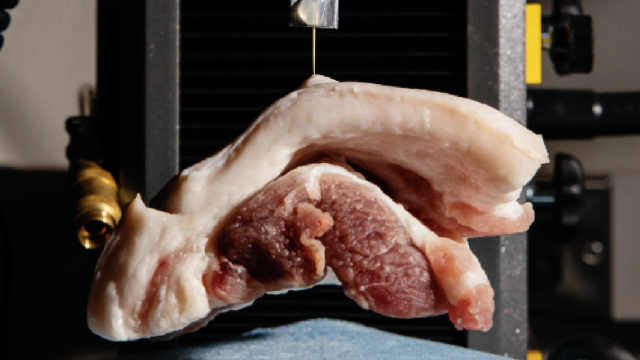One benefit of working at a university with an agricultural school is the availability of meat. That’s especially useful if you need something to stab cactus spines into.
The scientists weren’t as interested in the meat as they were in figuring out the relationship between a cactus spine’s structure and how well its stabs and stays anchored inside the thing it punctured. More generally, they hope to understand why cacti evolve different spines, and more generally how the shapes of spines in nature across species can depend on their functions.
And some spines were really good at doing their job. “One spine really impressed us with how tenaciously it hung onto things,” Stephanie Crofts, the study author form the University of Illinois, told Gizmodo.
The scientists began by collecting five spines each from six cactus specimens. They performed tests measuring the amount of force required to puncture the target material, and how much the spine pressed into the surface of the material before breaking through. They first punctured lab-grade polymer, but then wanted to work with something more biologically relevant. So they acquired some pork left over from the university’s agriculture school, as well as some store-bought chicken, said Crofts.
The spines varied in their puncturing abilities, but it turned out that barbed spines took far less force to poke a hole in a surface than the non-barbed spines did, according to the study published in the Proceedings of the Royal Society B. And the barbed spines stayed anchored. The spine from the jumping cholla cactus even lifted a half-pound slab of pork off of the working surface, requiring the scientists to pull the meat off.
Why does a spine need to be so spiny? Well, since new cacti can grow from certain parts of the jumping cholla that break off, called cladodes, perhaps the spines sticking firmly into an unlucky passerby has an evolutionary advantage. And unlike animals with pointy parts, cacti can’t decide who gets poked.
Barbed spines aren’t unique to cacti, though, and this lab at the University of Illinois studies all sorts of pokers. Porcupines, for example, similarly have barbed spines, demonstrating that both seem to have evolved to puncture easily and stay lodged inside of a victim. And it’s pretty wild to think about how two vastly different species from different kingdoms can evolve such similar parts.
“Researching these systems gives us the opportunity to compare evolution and biomechanics across both plants and animals,” Phil Anderson, study author and assistant professor in animal biology, told Gizmodo. “You don’t often have the chance to do a direct comparison like that.”
There’s more to it than just understanding animals. You’ve probably heard about using gecko feet or octopus suckers to create bio-inspired technology for humans. Studying a suite of spines could allow engineers to develop the ideal stabby-and-latchy contraption.
The study isn’t an exhaustive look at cactus spines, and the researchers have further avenues to explore. But it does offer some insight into why cacti evolve spines.
But more importantly, be careful how you carry meat when you’re walking by a jumping cholla cactus.
